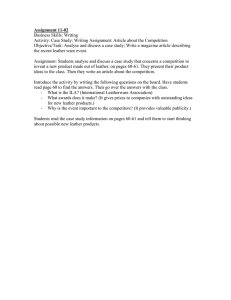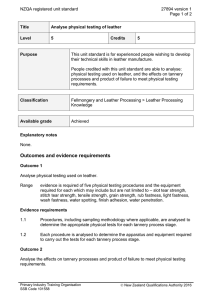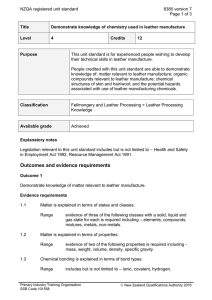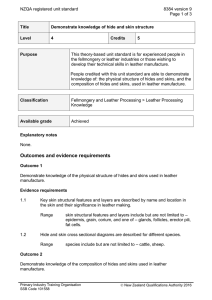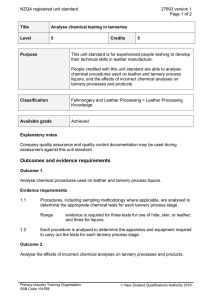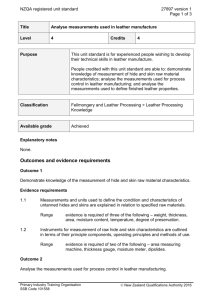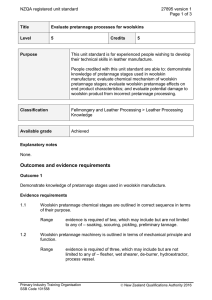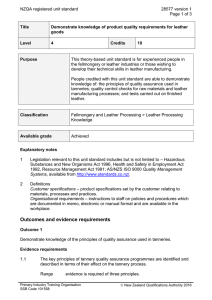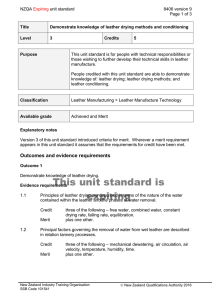NZQA registered unit standard 27896 version 1 Page 1 of 3
advertisement
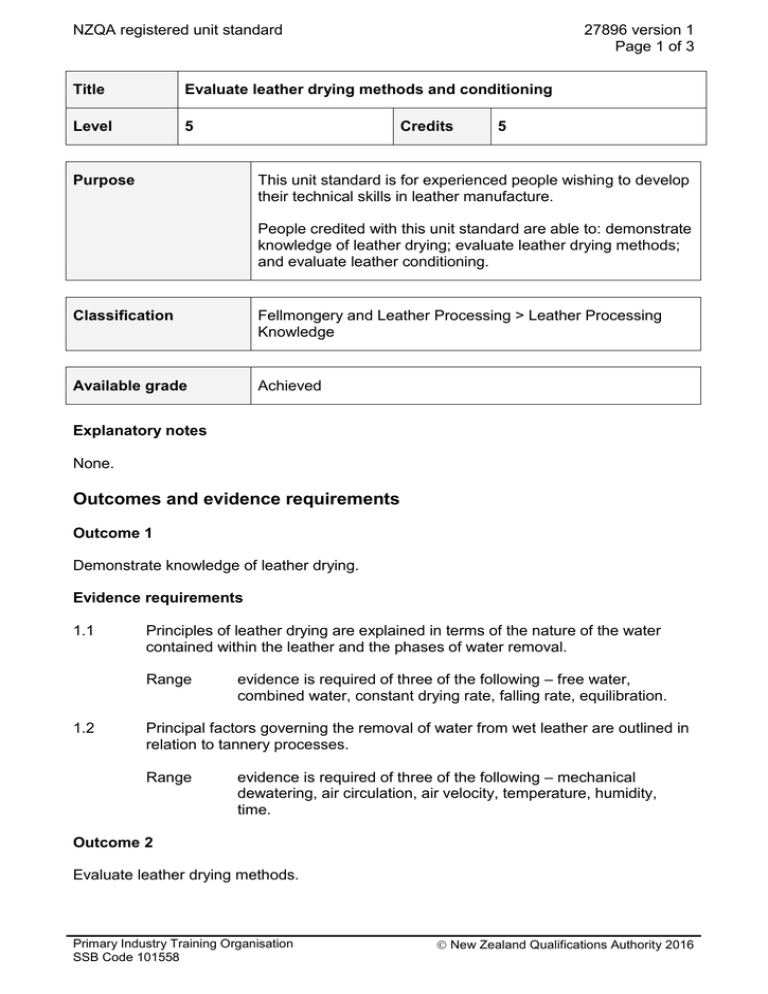
NZQA registered unit standard 27896 version 1 Page 1 of 3 Title Evaluate leather drying methods and conditioning Level 5 Credits Purpose 5 This unit standard is for experienced people wishing to develop their technical skills in leather manufacture. People credited with this unit standard are able to: demonstrate knowledge of leather drying; evaluate leather drying methods; and evaluate leather conditioning. Classification Fellmongery and Leather Processing > Leather Processing Knowledge Available grade Achieved Explanatory notes None. Outcomes and evidence requirements Outcome 1 Demonstrate knowledge of leather drying. Evidence requirements 1.1 Principles of leather drying are explained in terms of the nature of the water contained within the leather and the phases of water removal. Range 1.2 evidence is required of three of the following – free water, combined water, constant drying rate, falling rate, equilibration. Principal factors governing the removal of water from wet leather are outlined in relation to tannery processes. Range evidence is required of three of the following – mechanical dewatering, air circulation, air velocity, temperature, humidity, time. Outcome 2 Evaluate leather drying methods. Primary Industry Training Organisation SSB Code 101558 New Zealand Qualifications Authority 2016 NZQA registered unit standard 27896 version 1 Page 2 of 3 Evidence requirements 2.1 Leather drying methods are evaluated in terms of the equipment used and its operation. Range 2.2 evidence is required of three, which may include but are not limited to – paste, toggle, vacuum, radiation, hang, microwave. Drying methods for different leather types are evaluated in terms of suitability. evidence is required of three of the following – clothing, upper, upholstery, woolskins, vegetable leather. Range 2.3 Leather drying methods are evaluated in terms of advantages and disadvantages. evidence is required of two of the following – paste, toggle, vacuum, hang. Range Outcome 3 Evaluate leather conditioning. Evidence requirements 3.1 Reasons for conditioning leather after drying are evaluated in terms of product requirements. 3.2 Methods of leather conditioning are evaluated in terms of common tannery practices. evidence is required of two of the following – sawdusting, water spray, high frequency, drum conditioning. Range Replacement information Planned review date This unit standard replaced unit standard 8406. 31 December 2017 Status information and last date for assessment for superseded versions Process Version Date Last Date for Assessment Registration 1 21 February 2013 N/A Consent and Moderation Requirements (CMR) reference 0033 This CMR can be accessed at http://www.nzqa.govt.nz/framework/search/index.do. Primary Industry Training Organisation SSB Code 101558 New Zealand Qualifications Authority 2016 NZQA registered unit standard 27896 version 1 Page 3 of 3 Please note Providers must be granted consent to assess against standards (accredited) by NZQA, before they can report credits from assessment against unit standards or deliver courses of study leading to that assessment. Industry Training Organisations must be granted consent to assess against standards by NZQA before they can register credits from assessment against unit standards. Providers and Industry Training Organisations, which have been granted consent and which are assessing against unit standards must engage with the moderation system that applies to those standards. Requirements for consent to assess and an outline of the moderation system that applies to this standard are outlined in the Consent and Moderation Requirements (CMR). The CMR also includes useful information about special requirements for organisations wishing to develop education and training programmes, such as minimum qualifications for tutors and assessors, and special resource requirements. Comments on this unit standard Please contact the Primary Industry Training Organisation standards@primaryito.ac.nz if you wish to suggest changes to the content of this unit standard. Primary Industry Training Organisation SSB Code 101558 New Zealand Qualifications Authority 2016
